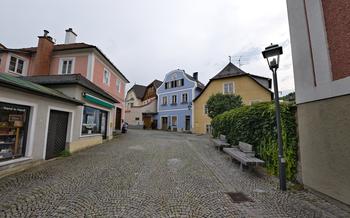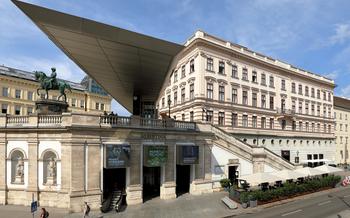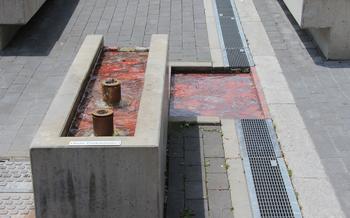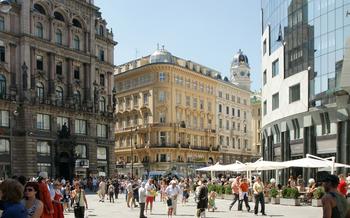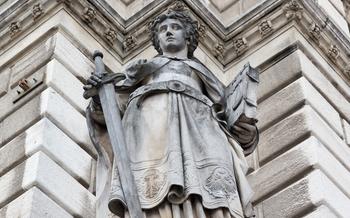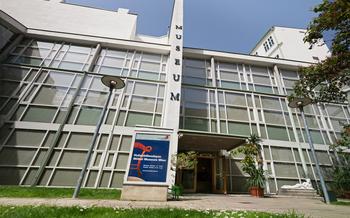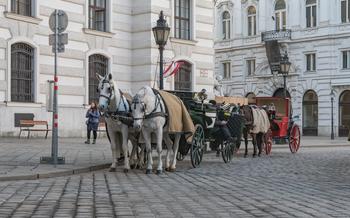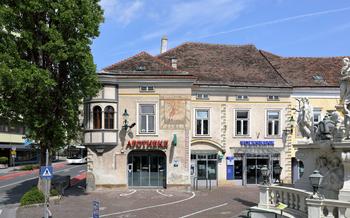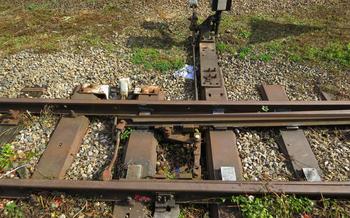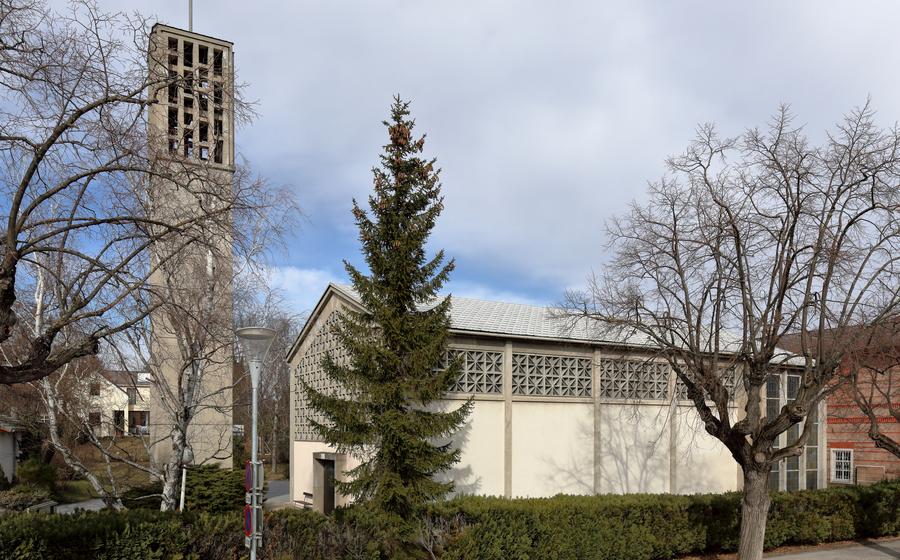
Albertina Museum and Art Gallery, Vienna
- Albertina Museum and Art Gallery
- Masterpieces of Art
- Impressionist and Modern Art
- Austrian Expressionism
- Graphic Art Collection
- Treasures of the Graphic Art Collection:
- Techniques and Styles:
- Creative Insights:
- Temporary Exhibitions
- Museum Shop and Café
- Educational Programs
- Architecture and Design
- Vienna Art Scene
- Getting There
- Planning Your Visit
- Accessibility and Inclusivity
- Insider Tip: Unveiling the Hidden Treasures of the Albertina
Albertina Museum and Art Gallery
In the heart of Vienna's cultural district, nestled among grand palaces and historic buildings, stands the Albertina Museum and Art Gallery. This architectural marvel, known for its distinctive Neo-Classical façade, houses one of the world's most impressive collections of graphic art, paintings, and sculptures. Founded in 1776 by Duke Albert of Saxe-Teschen, the museum's illustrious history is intertwined with the Habsburg dynasty and the rich artistic heritage of Austria.
Over the centuries, the Albertina has grown from a private collection to a renowned public institution, attracting art enthusiasts, historians, and curious travelers from around the globe. With its vast and diverse collection spanning various artistic movements, from Old Masters to contemporary art, the Albertina offers a captivating journey through the evolution of art and creativity.
The museum's highlights include masterpieces by Albrecht Dürer, Leonardo da Vinci, Michelangelo, Monet, Renoir, Van Gogh, Egon Schiele, and Oskar Kokoschka, among many others. Temporary exhibitions, often in collaboration with prestigious institutions worldwide, showcase groundbreaking works and offer fresh perspectives on art history.
A visit to the Albertina is an immersive experience that invites visitors to explore the depths of artistic expression, unravel the stories behind iconic works, and gain a deeper appreciation for the enduring power of art. Whether you're an art aficionado or simply seeking cultural enrichment, the Albertina promises an unforgettable encounter with some of history's greatest artistic treasures.
Practical Information:
- Address: Albertinaplatz 1, 1010 Vienna, Austria
- Hours: Daily, 10 am - 6 pm
- Admission Fees: Adults: €19; Students/Seniors: €17; Children (6-18): €15; Family Ticket (2 adults + 2 children): €42
Website: Albertina Museum
Masterpieces of Art
The Albertina Museum and Art Gallery boasts an impressive collection of masterpieces from different eras, showcasing the evolution of artistic styles and techniques. Among the highlights are paintings by Albrecht Dürer, whose intricate engravings and woodcuts provide a glimpse into the Renaissance world. Rubens's dynamic Baroque compositions, with their vibrant colors and dramatic lighting, create a sense of grandeur and movement. Caravaggio's Caravaggio's revolutionary approach to light and shadow, as seen in works like "The Entombment," captures the essence of the Baroque era.
Visitors can also admire the works of Austrian masters such as Gustav Klimt, whose iconic paintings, including "The Kiss," symbolize the Art Nouveau movement. Egon Schiele's expressive portraits and landscapes, marked by their emotional intensity and psychological depth, represent the transition to Expressionism. Oskar Kokoschka's bold colors and distorted forms convey the turmoil and anxieties of the early 20th century.
The Albertina's collection offers a comprehensive journey through the history of art, providing insights into the techniques, influences, and innovations that shaped the artistic landscape over the centuries. Each masterpiece tells a story, inviting visitors to delve into the minds and emotions of the artists who created them.
Impressionist and Modern Art
The Albertina Museum houses a remarkable collection of Impressionist and Modernist art, showcasing masterpieces from some of the most influential artists of these periods. Among the highlights are Claude Monet's "Water Lilies" and "Impression, Sunrise," which exemplify the essence of the Impressionist movement with their vibrant colors and fleeting, atmospheric effects.
Other notable works include Pierre-Auguste Renoir's "The Luncheon of the Boating Party," a lively depiction of a leisurely afternoon on the Seine River, and Vincent van Gogh's "Starry Night Over the Rhone," a stunning portrayal of the night sky over the river in Arles.
The Albertina's collection also features significant works by Austrian artists who played a pivotal role in the development of Impressionism and Modernism. Gustav Klimt's "The Kiss" is an iconic symbol of Viennese Art Nouveau, characterized by its intricate symbolism and shimmering gold leaf. Egon Schiele's "Dead City III" offers a haunting and introspective glimpse into the artist's inner turmoil and preoccupation with death and sexuality.
Comparing the Austrian Impressionist movement to its French counterpart reveals both similarities and distinctions. While both movements shared an emphasis on capturing the fleeting effects of light and atmosphere, Austrian artists often incorporated more symbolist and Expressionist elements into their work, reflecting the unique cultural and intellectual climate of Vienna at the turn of the 20th century.
Austrian Expressionism
In the early 20th century, Austria became a hub for a distinctive movement known as Austrian Expressionism. This artistic style emerged as a reaction to the tumultuous social and political climate of the time, characterized by its emotional intensity, psychological depth, and unique visual language.
The Albertina Museum houses a significant collection of Austrian Expressionist artworks, including masterpieces by Egon Schiele, Oskar Kokoschka, and other notable artists. Schiele's poignant portraits and self-portraits, with their elongated figures and raw emotional expression, are particularly striking. Kokoschka's vibrant landscapes and figurative compositions convey a sense of urgency and unrest, reflecting the anxieties of the era.
Austrian Expressionism drew inspiration from various sources, including Symbolism and Fauvism, but developed its own distinct character. The artists sought to depict the inner turmoil and subjective experiences of individuals, often using distorted forms, bold colors, and exaggerated perspectives.
This movement had a profound impact on the development of modern art, influencing artists far beyond Austria's borders. The works of Austrian Expressionists continue to captivate audiences with their emotional power and artistic innovation, providing a glimpse into the complexities of the human psyche and the challenges of a transformative period in history.
Graphic Art Collection
The Albertina Museum houses an extensive collection of graphic art, spanning from the early Renaissance to contemporary times. With over 50,000 drawings, watercolors, and prints, the collection offers a comprehensive overview of the development of graphic techniques and styles. Visitors can admire masterpieces by Leonardo da Vinci, Michelangelo, Rembrandt, and Dürer, among many others.
Treasures of the Graphic Art Collection:
-
Leonardo da Vinci's "Vitruvian Man": A study of human proportions that has become an iconic symbol of the Renaissance.
-
Michelangelo's "The Dream": A powerful and emotive drawing that captures the artist's unique style and mastery of the human form.
-
Rembrandt's "The Three Crosses": A dramatic etching that depicts the crucifixion of Jesus Christ with a haunting intensity.
-
Dürer's "Melancholia I": A complex and enigmatic engraving that explores the themes of melancholy and creativity.
Techniques and Styles:
The Graphic Art Collection showcases a wide range of techniques, including pen and ink, charcoal, watercolor, and lithography. Visitors can trace the evolution of these techniques over time and see how artists have used them to express their unique visions.
Creative Insights:
The Graphic Art Collection offers a glimpse into the creative process of some of the world's most renowned artists. Visitors can see preliminary sketches, studies, and discarded ideas, which provide valuable insights into the development of their masterpieces.
Temporary Exhibitions
The Albertina Museum frequently hosts a variety of temporary exhibitions that explore diverse themes and showcase works from different periods and cultures. These exhibitions often feature collaborations with other museums, galleries, and international artists, offering visitors a fresh perspective on art and history.
Advance booking is recommended for popular exhibitions, especially during peak tourist season, to avoid long queues and ensure entry. Online ticketing options are available on the museum's website, providing convenience and flexibility when planning your visit.
To make the most of temporary exhibitions, take some time to research the featured artists and themes beforehand. This will enhance your appreciation of the artworks and provide a deeper understanding of the creative process and historical context.
Join a guided tour specifically focused on the temporary exhibition to gain insights from knowledgeable art historians and curators. These tours often offer exclusive access to behind-the-scenes stories and anecdotes related to the artworks and their acquisition.
Temporary exhibitions at the Albertina Museum are a wonderful opportunity to discover new artistic perspectives, learn about different cultures, and engage with contemporary art practices. Don't miss the chance to experience these special exhibitions during your visit to Vienna.
Museum Shop and Café
The Albertina Museum houses a well-stocked museum shop where art enthusiasts can find a treasure trove of souvenirs and art-inspired gifts. From high-quality reproductions of famous artworks to unique jewelry, books, and postcards, the shop offers a wide range of items to commemorate your visit.
The museum also boasts a cozy Café Albertina, a perfect spot to relax and recharge after exploring the galleries. Enjoy a delicious pastry or light meal while immersing yourself in the artistic ambiance. Insider tip: Look for the hidden gems tucked away in the corners of the shop, such as limited-edition prints and exclusive artist collaborations.
Educational Programs
Enrich your visit to the Albertina Museum with a range of educational programs designed to engage and inspire visitors of all ages. Guided tours, led by knowledgeable art historians, provide an in-depth exploration of the museum's highlights, offering insights into the history, techniques, and significance of the artworks. Don't miss the opportunity to delve deeper into the world of art through captivating lectures, talks, and film screenings related to art history.
The museum also offers a variety of family-friendly activities, including workshops and educational resources, designed to spark creativity and curiosity in young minds. Participate in hands-on art projects, storytelling sessions, and interactive games that bring the artworks to life.
Personal Anecdote:
During my visit to the Albertina Museum, I had the pleasure of participating in a guided tour focused on the Impressionist and Modernist movements. Our enthusiastic guide, Dr. Maria, captivated the group with her knowledge and passion for the artworks. She shared fascinating stories about the artists' lives and techniques, bringing the paintings to life and shedding light on the social and historical context of the period.
The tour was an immersive experience that deepened my understanding and appreciation of the masterpieces on display. I highly recommend taking advantage of the educational programs offered by the Albertina Museum to enhance your visit and gain a richer perspective on the art world.
Architecture and Design
The Albertina Museum is housed in a magnificent building that is as much a work of art as the collection it holds. Originally a residential palace built in 1745, the Albertina was transformed into a museum in the 19th century. The building's neoclassical facade, with its imposing columns and grand entrance, sets the tone for the treasures within.
Over the years, the Albertina has undergone several renovations and expansions, resulting in a blend of architectural styles. The main building was extended with two wings in the 19th and 20th centuries, adding exhibition space and modern amenities to the museum.
In 2003, the Albertina underwent a major renovation that saw the addition of a striking contemporary extension. Designed by the Austrian architect Hans Hollein, the Albertina Modern wing features a bold glass and steel facade that contrasts with the historical building. Inside, the modern wing offers state-of-the-art exhibition spaces, a rooftop terrace, and a museum shop.
The Albertina's architecture and design reflect its commitment to showcasing art in a dynamic and engaging environment. The juxtaposition of historical and modern elements creates a unique atmosphere that enhances the visitor experience, making the Albertina one of the most architecturally significant museums in Vienna.
Vienna Art Scene
The Albertina Museum is an integral part of Vienna's vibrant and diverse art scene. It collaborates with other renowned museums and galleries, such as the Belvedere Museum and the Kunsthistorisches Museum, to present special exhibitions and events throughout the year.
Vienna is home to numerous art festivals and events, attracting art enthusiasts from around the world. The annual Vienna Art Week, held in November, showcases the city's contemporary art scene, featuring exhibitions, performances, and installations across various venues.
To fully immerse yourself in Vienna's art scene, explore the MuseumsQuartier, a vibrant cultural district housing several museums, galleries, and creative spaces. Take advantage of the Vienna City Card, which offers free or discounted admission to many museums and attractions, including the Albertina Museum.
Venture beyond the Albertina to discover hidden gems in Vienna's art scene. Stroll through the narrow streets of the Spittelberg district, where you'll find charming boutiques, galleries, and cafés. Visit the Secession Building, a masterpiece of Art Nouveau architecture, which hosts temporary exhibitions of contemporary art.
Getting There
The Albertina Museum is conveniently located in the heart of Vienna, making it easily accessible by various transportation options. For a seamless journey, consider taking advantage of Vienna's efficient public transportation system. Hop on the U-Bahn (subway) and alight at the Karlsplatz station, which is just a short walk from the museum. Alternatively, several bus lines, including the 1A, 2A, and 3A, stop nearby, offering a scenic route to the Albertina.
For those arriving by car, limited parking is available in the vicinity of the museum. However, it's advisable to utilize public transportation or explore alternative parking options to avoid the hassle of finding a spot. The Albertina is committed to accessibility, providing designated spaces for visitors with disabilities.
Whether you prefer the convenience of public transportation, the flexibility of driving, or the eco-friendly option of cycling, the Albertina Museum is effortlessly accessible, ensuring a smooth and enjoyable visit for all.
Planning Your Visit
To make the most of your visit to the Albertina Museum, careful planning is essential. Start by setting aside at least two to three hours for your exploration. The museum's vast collection and engaging exhibitions warrant sufficient time to appreciate the masterpieces and delve into the artistic movements represented.
Consider purchasing a combo ticket, which grants you access to both the Albertina Museum and other prominent attractions in Vienna, such as the Kunsthistorisches Museum or the Belvedere Museum. This option offers significant savings and allows you to explore multiple cultural venues in one go.
To avoid the crowds, plan your visit for a weekday morning or late afternoon. Weekends and public holidays tend to be busier, especially during the peak tourist season. If you're short on time, focus on the highlights of the collection, such as the works of Monet, Renoir, Van Gogh, and Egon Schiele.
Take advantage of the audio guide, which provides insightful commentary on selected artworks and historical context. For a more immersive experience, book a guided tour led by an expert art historian. These tours offer a deeper understanding of the museum's collection and its significance in the history of art.
Accessibility and Inclusivity
The Albertina Museum is committed to providing an accessible and inclusive experience for all visitors. Wheelchair accessibility is ensured throughout the museum, with elevators and ramps connecting the different floors. Visitors with visual impairments can take advantage of audio guides and descriptive tours, which provide detailed descriptions of the artworks. Family-friendly facilities, such as stroller parking and changing tables, make the museum a welcoming environment for families with young children. The museum also offers a range of educational programs and resources designed to cater to visitors of all ages and abilities. These include guided tours and workshops tailored to the needs of different audiences, as well as lectures, talks, and film screenings related to art history.
Insider Tip: Unveiling the Hidden Treasures of the Albertina
Beyond the renowned masterpieces, the Albertina Museum holds hidden gems waiting to be discovered by curious visitors. One such secret spot is the Staterooms, a series of opulent chambers once reserved for the Habsburg family. These rooms, adorned with intricate tapestries, crystal chandeliers, and elegant furniture, offer a glimpse into the lavish lifestyle of the Austrian monarchy.
Another hidden gem is the Graphic Art Cabinet, home to a vast collection of drawings, watercolors, and prints. Here, visitors can admire the delicate lines and masterful techniques of Old Masters like Dürer and Rembrandt, as well as modern masters such as Picasso and Klimt.
For those seeking breathtaking views, the Rooftop Terrace offers a panoramic vista of Vienna's cityscape. From this vantage point, visitors can soak in the beauty of iconic landmarks like the Hofburg Palace and St. Stephen's Cathedral, while enjoying a moment of tranquility amidst the bustling city.
To capture the essence of the Albertina Museum, venture beyond the main galleries and explore these hidden treasures. With a keen eye and a sense of curiosity, you'll uncover the secrets that make this museum truly extraordinary.
A personal anecdote to enhance the insider tip:
During my visit to the Albertina, I stumbled upon a hidden gem tucked away in a corner of the Old Masters Gallery. It was a small, unassuming painting by a lesser-known artist, depicting a serene landscape with soft, muted colors. The simplicity and beauty of the work captivated me, and I spent several minutes contemplating its hidden depths. This unexpected discovery reminded me of the countless treasures that await those who take the time to explore beyond the surface of the Albertina's renowned collection.
